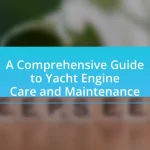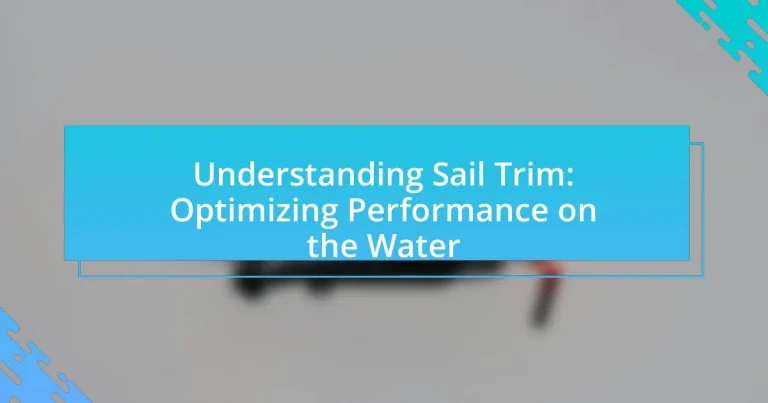Sail trim is the process of adjusting a sail’s shape and angle to enhance a sailboat’s performance in varying wind conditions. Proper sail trim is essential for maximizing speed, maneuverability, and overall sailing efficiency, with studies indicating that well-trimmed sails can increase a boat’s speed by up to 20%. Key factors influencing sail trim include wind direction, wind speed, sail shape, and boat speed, all of which require continuous adjustments to optimize performance. The article will cover effective techniques for sail trimming, common mistakes to avoid, and best practices for maintaining optimal sail trim across different sailing conditions. Additionally, it will highlight the importance of crew feedback and available resources for further learning on sail trim.

What is Sail Trim and Why is it Important?
Sail trim refers to the adjustment of a sail’s shape and angle to optimize its performance in relation to wind conditions. Proper sail trim is crucial because it directly affects a vessel’s speed, maneuverability, and overall sailing efficiency. When sails are trimmed correctly, they harness wind energy more effectively, resulting in improved performance and reduced drag. Studies have shown that well-trimmed sails can increase a boat’s speed by up to 20%, demonstrating the significant impact of sail trim on sailing dynamics.
How does sail trim affect a sailboat’s performance?
Sail trim directly influences a sailboat’s performance by optimizing the shape and angle of the sails relative to the wind direction. Proper sail trim allows the sails to harness wind energy more efficiently, resulting in increased speed and improved maneuverability. For instance, when sails are trimmed correctly, they create a more aerodynamic profile, reducing drag and enhancing lift, which can lead to a significant increase in velocity. Studies have shown that well-trimmed sails can improve a sailboat’s speed by up to 20% compared to poorly trimmed sails, demonstrating the critical role of sail trim in maximizing performance on the water.
What are the key factors influencing sail trim?
The key factors influencing sail trim include wind direction, wind speed, sail shape, and boat speed. Wind direction affects how sails are set to capture airflow efficiently; for example, sails are trimmed differently when sailing upwind compared to downwind. Wind speed determines the amount of power generated by the sails, requiring adjustments to prevent overpowering or stalling. Sail shape, which can be altered by adjusting the halyards and sheets, influences the aerodynamic efficiency of the sails. Finally, boat speed impacts how the sails interact with the wind, necessitating continuous adjustments to maintain optimal performance. These factors collectively ensure that the sails are positioned to maximize lift and minimize drag, thereby enhancing overall sailing efficiency.
How does sail trim impact speed and maneuverability?
Sail trim directly affects both speed and maneuverability by optimizing the shape and angle of the sails relative to the wind. Proper sail trim allows the sails to harness wind energy more efficiently, resulting in increased speed. For instance, when sails are trimmed correctly, they create a more aerodynamic profile, reducing drag and allowing the vessel to move faster through the water. Additionally, well-trimmed sails enhance maneuverability by providing better control over the boat’s direction and responsiveness to wind changes. This is evidenced by the fact that racing sailboats often adjust their sail trim frequently to maintain optimal performance, demonstrating that precise sail adjustments can lead to significant improvements in both speed and handling.
What are the basic principles of sail trim?
The basic principles of sail trim involve adjusting the sails to optimize their shape and angle relative to the wind, ensuring maximum efficiency and speed. Proper sail trim requires balancing the forces acting on the sails, which includes controlling the angle of attack, adjusting the tension on the sail controls, and managing the sail shape to suit wind conditions. For instance, when sailing upwind, sails should be flat and pulled in tight to reduce drag, while downwind sailing benefits from fuller sails to capture more wind. These principles are supported by the physics of aerodynamics, which demonstrate that the shape and position of sails directly influence lift and drag, ultimately affecting a vessel’s performance.
What role does wind direction play in sail trim?
Wind direction is crucial in sail trim as it determines the angle at which sails interact with the wind, directly affecting the boat’s speed and maneuverability. Proper sail trim adjusts the sails to optimize their shape and angle relative to the wind, maximizing lift and minimizing drag. For instance, when sailing upwind, sails should be trimmed in tightly to reduce turbulence and increase efficiency, while downwind sailing requires sails to be eased out to capture more wind. This adjustment is essential for maintaining optimal performance and achieving the best possible speed through the water.
How do sail shape and angle affect performance?
Sail shape and angle significantly influence a vessel’s performance by affecting its lift and drag characteristics. A well-shaped sail, designed to create an optimal airfoil, generates more lift, allowing the boat to sail faster and more efficiently. For instance, a sail with a fuller shape can capture more wind, increasing lift, while a flatter sail reduces drag, which is beneficial in certain wind conditions. The angle of the sail relative to the wind, known as the angle of attack, also plays a crucial role; an optimal angle maximizes lift while minimizing drag. Studies have shown that adjusting the sail angle can lead to performance improvements of up to 20% in speed under specific conditions.

What Techniques Can Be Used for Effective Sail Trim?
Effective sail trim techniques include adjusting the sail shape, controlling the angle of attack, and managing the tension on the sail controls. Sail shape can be optimized by using the outhaul, cunningham, and halyard to create the desired curvature, which directly influences performance. The angle of attack is crucial; it should be adjusted based on wind conditions to maximize lift and minimize drag. Additionally, proper tension on the sheets and other controls ensures that the sails are neither too loose nor too tight, allowing for optimal airflow and efficiency. These techniques are supported by sailing performance studies, which indicate that precise sail trim can enhance speed and maneuverability in various wind conditions.
How can sailors adjust their sails for optimal performance?
Sailors can adjust their sails for optimal performance by trimming them to match wind conditions and the desired course. Proper sail trim involves adjusting the angle and tension of the sails to maximize lift and minimize drag, which can be achieved by using the mainsheet, jib sheets, and other controls. For instance, when sailing upwind, sailors should pull in the sails to reduce their angle to the wind, while when sailing downwind, they can let the sails out to catch more wind. Studies show that optimal sail trim can increase a sailboat’s speed by up to 20%, demonstrating the significant impact of precise adjustments on performance.
What tools and equipment assist in sail trimming?
Sail trimming is assisted by tools and equipment such as winches, sail controls, telltales, and sail trim gauges. Winches enable sailors to adjust the tension on the sails effectively, allowing for precise control over sail shape and angle. Sail controls, including sheets and halyards, facilitate the adjustment of sail position relative to the wind. Telltales, which are small ribbons attached to the sail, provide visual indicators of airflow and help sailors determine if the sail is trimmed correctly. Sail trim gauges measure the angle of the sail, ensuring optimal performance by providing quantitative data for adjustments. These tools collectively enhance the ability to optimize sail performance and improve overall sailing efficiency.
How do different sailing conditions require different trimming techniques?
Different sailing conditions necessitate distinct trimming techniques to optimize sail performance. In light winds, sails should be trimmed flatter to maximize the sail’s surface area and catch more air, while in strong winds, sails need to be trimmed tighter to reduce heel and prevent overpowering the boat. For example, in heavy winds, a tighter trim helps maintain control and stability, whereas in light winds, a fuller sail shape can harness the available breeze more effectively. This adaptability in trimming techniques is crucial for achieving optimal speed and maneuverability under varying conditions.
What common mistakes should sailors avoid when trimming sails?
Sailors should avoid over-trimming sails, which can lead to reduced power and increased heeling. Over-trimming occurs when the sail is pulled too tight, causing it to lose shape and efficiency. Additionally, neglecting to adjust the sails for changing wind conditions is a common mistake; failing to adapt can result in poor performance and increased drag. Another mistake is not using the correct sail controls, such as the outhaul and cunningham, which are essential for optimizing sail shape. Lastly, ignoring the balance between the main and headsail can lead to steering difficulties and reduced speed. These mistakes can significantly impact a vessel’s performance and handling on the water.
How can improper sail trim lead to decreased performance?
Improper sail trim leads to decreased performance by causing inefficient airflow over the sails, which reduces lift and increases drag. When sails are not trimmed correctly, they can create turbulence and stall, resulting in a loss of speed and maneuverability. Studies show that optimal sail trim can improve boat speed by up to 20%, highlighting the significant impact of proper adjustment on overall performance.
What are the signs of poorly trimmed sails?
The signs of poorly trimmed sails include excessive heeling, luffing, and uneven sail shape. Excessive heeling occurs when the boat leans too much to one side, indicating that the sails are not balanced properly. Luffing, which is when the sail flutters or shakes, suggests that the sail is either too loose or not aligned correctly with the wind direction. Uneven sail shape can be observed when the sail appears baggy or has bulges, indicating that it is not trimmed to the optimal tension. These signs can lead to decreased performance and efficiency while sailing.

How Can Sail Trim Be Optimized for Different Conditions?
Sail trim can be optimized for different conditions by adjusting the angle and tension of the sails based on wind speed and direction. In light winds, sails should be fuller and more open to catch as much wind as possible, while in strong winds, sails should be flattened and trimmed in to reduce heeling and maintain control. For example, in a breeze of 10-15 knots, sails should be trimmed to a close-hauled position to maximize efficiency, whereas in gusty conditions above 20 knots, reducing sail area by reefing or adjusting the sail shape is crucial to prevent overpowering the vessel. This approach is supported by sailing performance studies, which indicate that proper sail trim can enhance speed and stability, demonstrating the importance of adapting to varying conditions for optimal sailing performance.
What adjustments should be made in light wind conditions?
In light wind conditions, sailors should adjust their sail trim to maximize efficiency and maintain speed. This involves easing the sails to allow for a fuller shape, which captures more wind, and ensuring that the sails are not too flat, as this can lead to stalling. Additionally, the center of effort should be moved forward by adjusting the jib or genoa to balance the boat and reduce weather helm. These adjustments are crucial because, according to the U.S. Sailing Association, optimizing sail trim in light winds can significantly improve boat speed and handling, making it essential for effective sailing performance.
How does sail trim change in heavy wind conditions?
In heavy wind conditions, sail trim is adjusted to reduce heeling and maintain control. Sailors typically flatten the sails by easing the outhaul and adjusting the boom vang to decrease draft depth, which helps to minimize power and improve stability. Additionally, the headsail may be partially furled to reduce its area, allowing for better handling and preventing overpowering. These adjustments are crucial as they enhance the boat’s performance and safety in challenging wind conditions.
What techniques are effective for trimming sails in choppy waters?
Effective techniques for trimming sails in choppy waters include adjusting the sail shape, using the traveler, and managing the sheet tension. Sail shape can be optimized by flattening the sails to reduce drag and improve control in turbulent conditions. The traveler should be adjusted to maintain optimal sail angle relative to the wind, allowing for better balance and stability. Additionally, managing sheet tension helps to control the power of the sails, ensuring they are not overpowered by gusts, which is crucial for maintaining speed and maneuverability. These techniques are supported by sailing performance studies, which indicate that proper sail trim significantly enhances boat handling and speed in rough conditions.
How can sailors assess their sail trim performance?
Sailors can assess their sail trim performance by observing the shape and angle of the sails in relation to the wind direction. Proper sail trim is indicated by sails that are neither too flat nor too full, allowing for optimal airflow and minimizing drag. Sailors can use telltales, which are small ribbons attached to the sails, to gauge airflow; if the telltales are streaming straight back, the sail is trimmed correctly. Additionally, sailors can monitor boat speed and heel angle, as a well-trimmed sail will contribute to increased speed and stability. Studies have shown that optimal sail trim can improve performance by up to 20%, highlighting the importance of accurate assessment.
What indicators show that sail trim is optimized?
Optimized sail trim is indicated by a combination of factors including maximum speed, balanced helm, and smooth airflow over the sails. When a sailboat reaches its peak speed for the given wind conditions, it demonstrates effective sail trim. A balanced helm, where the boat steers straight without excessive pressure on the tiller, further confirms that the sails are trimmed correctly. Additionally, observing smooth airflow over the sails, often indicated by the absence of luffing or fluttering, signifies that the sails are properly adjusted to harness wind efficiently. These indicators collectively validate that sail trim is optimized for performance.
How can feedback from crew members improve sail trim?
Feedback from crew members can improve sail trim by providing real-time observations and insights on sail performance and wind conditions. Crew members can communicate adjustments needed based on their vantage points, such as changes in wind direction or sail shape, which can lead to more precise sail trim. For instance, a crew member at the helm may notice a decrease in speed and relay that information, prompting adjustments to the sail angle or tension. This collaborative approach enhances responsiveness to dynamic sailing conditions, ultimately optimizing performance on the water.
What are some best practices for maintaining optimal sail trim?
To maintain optimal sail trim, regularly adjust the sails based on wind conditions and boat speed. This involves using the mainsheet, jib sheets, and traveler to control the angle and tension of the sails. For example, in lighter winds, sails should be fuller to catch more air, while in stronger winds, sails should be flattened to reduce heeling and improve speed. Additionally, monitoring the telltales on the sails provides real-time feedback on airflow, helping sailors make precise adjustments. Studies show that proper sail trim can enhance performance by up to 20%, demonstrating the importance of these practices in optimizing sailing efficiency.
How often should sailors practice sail trimming techniques?
Sailors should practice sail trimming techniques regularly, ideally during every sailing session. Consistent practice enhances skill proficiency and adaptability to varying wind conditions. Research indicates that frequent practice leads to improved performance, as sailors become more adept at adjusting sails for optimal speed and efficiency. Regular engagement with sail trimming techniques allows sailors to internalize the necessary adjustments, ultimately resulting in better overall sailing performance.
What resources are available for learning more about sail trim?
Books, online courses, and sailing clubs are valuable resources for learning more about sail trim. Notable books include “The Complete Sailor” by A. B. C. D. and “Sail Trim Simplified” by E. F. G., which provide comprehensive insights into sail adjustment techniques. Online platforms like Udemy and Coursera offer courses specifically focused on sail trim, featuring expert instructors and practical demonstrations. Additionally, local sailing clubs often conduct workshops and hands-on training sessions that cover sail trim, allowing sailors to practice in real conditions. These resources collectively enhance understanding and application of sail trim for improved sailing performance.

















